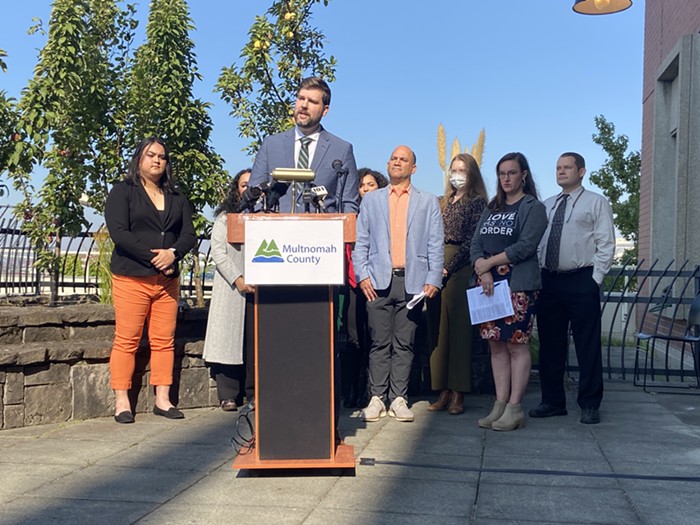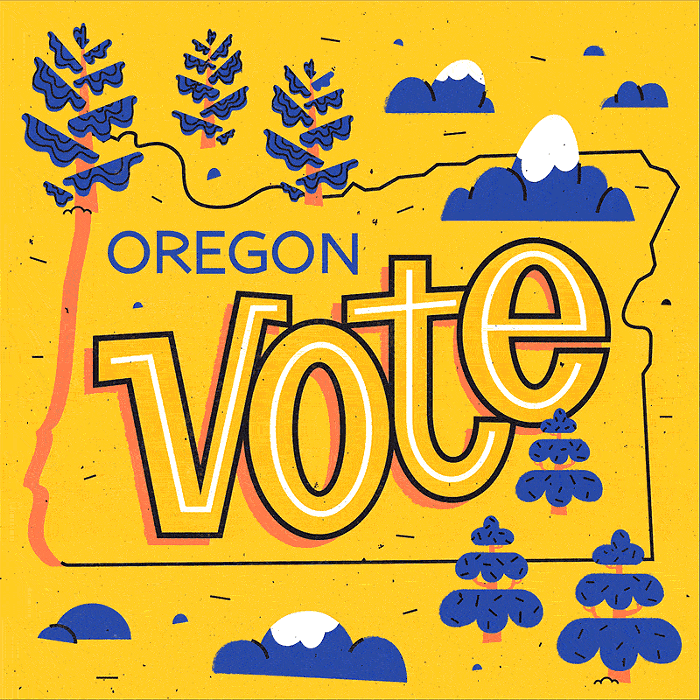BARBED WIRE covers the locked metal gate in front of us. It's strung across poles that stretch higher than my head, and its tendrils reach into the thorny blackberry bushes that sit on either side.
The no-nonsense assemblage is convincing in a way that the "no trespassing" signs we've blithely ignored so far were not. We're clearly supposed to turn around and head back to civilization. Except we don't.
I unbutton my shirt and drape it over one of the strands, which helps me make an awkward climb over the barbs—my tour guide, Bob Sallinger of the Audubon Society of Portland, does the same. We dust ourselves off and gawk at the young, rare cottonwoods stretching skyward all around us.
We've reached the hushed interior of West Hayden Island, Portland's last great tract of (mostly) untrammeled wilderness—and, maybe one day, the home of a diesel-belching, ground-shaking deepwater terminal for the Port of Portland.
Our timing couldn't be better. This Sunday, July 29, will mark precisely two years since the Portland City Council agreed to seriously consider such a development—a dream the Port has nurtured for decades. It's also been more than seven months since the council's original deadline for a decision on whether to annex and rezone the land so the Port can start making that dream a reality.
And now another deadline is rapidly approaching: January 2013. That's when a new mayor and maybe two new city commissioners—bringing a whole new set of idiosyncrasies and priorities—will take office. What's more concerning is that, after all that time, and after thousands of pages of reports and dozens of meetings, significant questions still remain.
Will a Port expansion pencil out? Is it even worth the tradeoff in environmental damage? Does the city have enough chutzpah to hold the port accountable? Is the city, as the clock runs out, trying to ram a deal through?
Sallinger, a gnome-like character who drives a brittle VW bus, holds no illusions as we hike down the bucolic path beckoning us.
"Everything I show you today," he says, gesturing, "will basically be obliterated."
* * *
"MARINE INDUSTRIAL DEVELOPMENT"
If two years seems like a painfully long time, then consider that the Port of Portland and the city's business community have been waiting close to 30 years for a chance to pave over some, or most, of West Hayden Island's 800 acres of grasslands, wetlands, forests, and shallow-water habitat.
Metro tucked the parcel into the region's urban growth boundary back in 1983, reserving it for "marine industrial development." The Port then bought it all in 1994 and it's been trying to lay the groundwork for development ever since.
Why build? Job, jobs, and more jobs, officials say. And not now, but some day. Demand for new marine terminals will eventually exceed the Port's array of terminals along the Willamette and Columbia Rivers, and there's no other waterfront parcel in Oregon, officials say, that makes as much sense.
"We will have a shortage of industrial land, and especially marine industrial land," says Josh Thomas, a spokesman for the Port. "It's not about today. It's about decades down the road. Realistically it's going be at least 10 years before development takes place, at a minimum."
The Port hasn't been this close to its goal in years. A previous bid to annex and develop West Hayden Island collapsed in 2000, partly because of community outcry and partly because the Port couldn't find any takers willing to set up shop in a new terminal.
The current proposal calls for dropping a terminal on the 300 acres of West Hayden Island closest to the big box stores of Jantzen Beach. In return, the Port is supposed to open the 500 remaining acres to the public and spend millions to offset, elsewhere along the Columbia River, the environmental havoc of that construction. So far, that amounts to a promise to plant new trees on Government Island.
Striking that balance won't be easy.
Sallinger, during our unauthorized tour, made that point by taking me close to the heart of the would-be terminal: a towering copse frequented by deer and bald eagles. It sits, along with other pristine and thriving forestland, smack dab in the middle of what would be the new complex. Those trees? The grasslands surrounding them? The gentle riverbanks nearby that provide respite and food for more than a dozen types of salmon and steelhead?
They'll give way to parking lots, circled by a fortress of train tracks and served by beefed-up access roads. And because West Hayden Island bides its time in a floodplain—finding itself entirely submerged as recently as 1996—those parking lots will also sit atop impossible acres of new topsoil. If we could somehow time travel 20 years into the future, we'd wind up entombed in nearly two dozen feet of dirt.
"It's a surreal amount," says Sallinger, the Audubon Society's conservation director.
Moreover, even the city and the Port's own studies raise doubts about the project's financial benefits—the primary justification for the razing of so much wilderness.
According to a report by respected analyst ECONorthwest, the project is "likely" to pencil out, after environmental mitigation. But it comes with a caution: The benefits of bonus port capacity will be spread globally, while the costs will pile up locally.
"The goods currently expected to flow through West Hayden Island (autos, grain, or dry bulk) will not come from local firms or end up in local stores," analysts wrote. "Instead West Hayden Island would serve as a convenient transshipment point in part of a much longer supply chain... Important for our analysis, most of these benefits do not occur in the Portland metro area."
ECONorthwest also noted "technological changes" in recent years that have allowed shippers to cut workers while still increasing production: "This change has potentially reduced the benefits of ports to their local economies."
Moreover, ECONorthwest also fretted about the effects of competition with nearby ports including the Port of Vancouver and wondered whether Vancouver could, in fact, accommodate "some (and perhaps all)" of whatever growth in demand is forecast for Portland.
Thomas, the Port spokesman, quibbled with some of those findings, saying marine industry contributes millions of dollars in tax revenue to the state. He also rejected the idea that the Port could get by without expanding to Hayden Island.
"That's what this comes down to," he says. "Planning for the future."
That line of thinking doesn't sway Sallinger—or other skeptics. "There's real skepticism that this is just a cursory exercise."
* * *
"A Team Against All of Us"
Mayor Sam Adams, his necktie loosened just so, was clutching a wireless microphone and eagerly bounding around a stuffy, smelly hotel conference room at Jantzen Beach. He looked more like a talk show host than a politician.
Adams was emcee at a July 17 open house that drew many of the project's most vocal skeptics—primarily neighbors who live on East Hayden Island. As the participants raised their hands, Adams would circle around and stick the mic in front of their faces. Then he'd sum up their questions and beefs, and facilitators would dutifully jot it all down on large pieces of paper that wound up taped to the walls.
Few speakers, if any, pulled their punches. Adams' office is the architect of the golden-ratio-like 300-acre/500-acre split. And the moist air was equally thick with fear that city hall is rolling over just to give the mayor another item for his legacy list.
"It appears you all are in bed together," says Jimmé Peters, a woman who stood up in the back of the room. "The Port is the applicant to the city. But it seems like it's a team—a team against all of us."
Adams, before he left for a family obligation and turned the restive crowd over to a pair of Portland Bureau of Planning and Sustainability staffers, tried to reassure the room that he, at least, is keeping an open mind.
"The reason I'm here is to listen. Not only to what you say, but how you say it," he offered, also making sure to call out another city council observer, Commissioner Amanda Fritz.
But the crowd, it turns out, has good reason to cling to its doubts. For a town that thrives on endless debate and public process, a lot of the work on West Hayden Island, especially in recent months, had been suspiciously dark.
The breaking point came in mid-June, on the eve of a key meeting of a volunteer advisory committee working to fine-tune whatever annexation deal might emerge between the port and the city. With only hours to process it, members of the committee were handed a substantial draft of that contract.
Worse, they were told the whole thing would be going before the city's Planning and Sustainability Commission just a few weeks later, some time in August. Next up would have been city council.
Sallinger, for one, went nuclear with his disgust. He quit the committee and then made sure to tell the Oregonian about it, saying he thought the whole thing was a "sham." Pointing to drafts of the contract he got his hands on through a public records request, and then passed around to reporters, he pointed out clause after clause where it looked as if the city had ceded its leverage to the Port.
Instead of permanently preserving the leftover 500 acres, the draft contract spoke of only a 25-year guarantee. Plans for forest and wetlands replacement were tepid. Benchmarks for how much the Port ought to spend to offset the terminal's ills weren't firm. And the language on contract disputes included a loophole that basically allowed the Port to walk away from the whole deal—while keeping its 300-acre terminal.
After Sallinger's explosion, city staffers promised to slow things down. And they did. The Planning and Sustainability Commission now won't consider the annexation contract until October, at the earliest. City staffers also reminded everyone at the open house that they intend to push back on many of the points Sallinger raised.
"We didn't think the initial proposal was good enough," city planner Eric Engstrom told the room. "Has this already been decided? No."
Susie Lahsene, the Port's West Hayden Island project manager, says the Port can live with most of what the city will be seeking ("We're easy," she joked). She agreed that disputes could go before a neutral arbitrator. She endorsed stronger language on costs and permanent protections for the leftover natural habitat.
She's less willing to bend, however, on how much the Port should spend on righting its ecological wrongs.
"At the end of the day, things have to pencil out," she said. "There are things that are reasonable, and there are things that are excessive."
* * *
"Spit it Out or Swallow"
The hue and cry this summer also produced one other (at least partial) victory for the community. In a first for the city, planners looking at the West Hayden Island project will attempt to assemble what's known as a health impact assessment, hopefully in time for the October vote by the Planning and Sustainability Commission.
The health study—no easy task in such a relatively small timeframe—will look at how factors like noise, air pollution, and traffic will affect the communities neighboring West Hayden Island. It came recommended in the ECONorthwest economic study, which included the alarming statistic that life expectancy for residents near the Port of Oakland was 10 years less than in other parts of town.
The city plans on asking a pair of health organizations to help vet the study, and it's also working with Multnomah County's public health officer.
"If it looks like we're still figuring out what that all means," says Adams, "it's because we are."
But even that welcome step has a fairly big problem: Because a detailed development proposal is years away, the health study's results may not be meaningful. Or at least they'll be cast that way.
"It would be a shame to ignore" improvements in technology over the next several years, Lahsene says. "You really can't do that until you have a proposal in front of you."
"You can always take the worst-case scenario," Sallinger, of the Audubon Society, scoffs. "It's not that complicated."
The Planning and Sustainability Commission is also insisting on a health study before it decides whether to recommend annexation—the last hurdle before the city council weighs in. Under the newly approved Portland Plan—the document that guides the commission's work and, incidentally, another legacy piece pushed insanely hard by Adams—"health" is part of the rubric the city must now apply when vetting development pitches.
So is the word "equity." Remember the concern that a lot of the upside of a new terminal might land outside Portland, leaving the locals to bear the brunt of the downside? That hardly sounds equitable. And now, thanks to the Portland Plan, that's something else the planning commission, and the city council, must consider.
"The council approved the [Portland Plan]," says the planning commission's chairman, André Baugh, who sees West Hayden Island as a test of the city's fealty to its plan. "Are you going to follow what you voted for?"
Baugh swears he's not feeling any pressure to schedule a vote this year, and avoid tipping a council decision into 2013. But he also said, when asked if the planning commission might ask for more time, "we'll see when we get closer to October."
And even if the planning commission recommends saying no to West Hayden Island, of course, the city council is always free to reject that recommendation and say yes.
"We just chew their food," Chris Smith, a planning commissioner, says of city council. "It's up to them if they want to spit it out or swallow."













